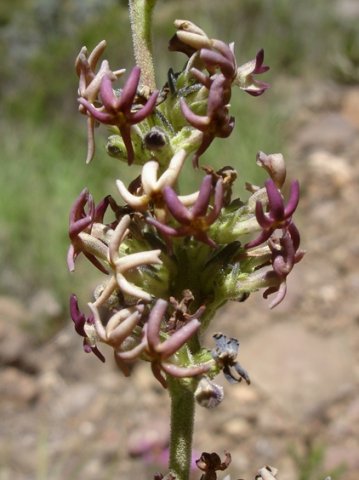Manulea crassifolia subsp. thodeana flowers

Author: Ivan Lätti
Photographer: Judd Kirkel Welwitch
The flowers of Manulea crassifolia subsp. thodeana grow in a raceme that starts off short but may be 15 cm long by the time the fruits develop.
The five petal lobes of each flower spread at the end of long, thin, cylindrical corolla tubes around the small flower mouths and recurve variably but gracefully. The outsides of the faintly hairy, cylindrical corolla tubes are cream. So are the outside surfaces of the petal lobes visible in picture. The lateral margins of the long, narrow lobes curve down, causing the lobes to be rounded, finger-like. The corolla tubes are about twice as long as the hairy, green and pointy sepals at their backs that veer outwards.
Flower colour of M. crassifolia generally varies from pale buff and yellow to white. M. crassifolia subsp. thodeana is the only one that has or sometimes has mauve flowers, ageing to cream. There are two unequal pairs of stamens in each flower, one of which is hidden inside the tube. Flowering happens in midsummer, maybe longer.
Manulea plants are sometimes called vingertjies (little fingers) in Afrikaans, referring to the shape of their petal lobes. The species shares the feature of a dense raceme of five finger-like corolla lobes per flower with manuleas generally (Trauseld, 1969; iSpot; JSTOR).

